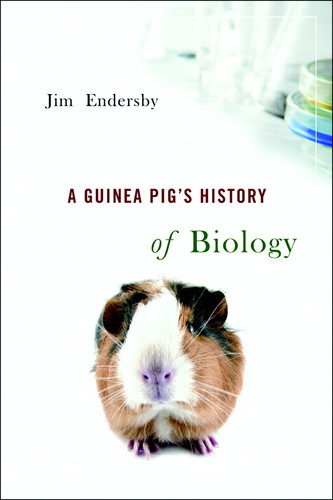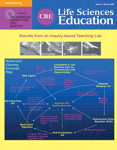Model Organisms: Guinea Pigs & Co.
The title of this book has prospective mass appeal. Anyone in and outside biology is familiar with a particular model organism for teaching, research, or both. Have you ever wondered how a particular model organism emerged as such? If you answered yes, then you are in for a treat. If you answered no, you are still in for a different sort of treat—a historical account of 12 model organisms ranging from an extinct species (the quagga, Equus quagga) to a genetically engineered species (OncoMouse®). Jim Endersby, a professor of history at the University of Sussex in the United Kingdom, has crafted an engaging book that covers wide territory as an account in biological history related to the use of various organisms and how these organisms have shaped our understanding of biological process, notably evolution, genetics, and physiology. The information in A Guinea Pig's History could help instructors at any level add a historical slant to their lectures, because there is plenty of material to enrich any life science course.
Each of the 12 chapters may be read in any particular order, although reading them in chronological order makes one appreciate how far we have come in terms of innovation and manipulation of organisms to answer all sorts of questions in biology. Some chapters are more effective than others, whether it is in terms of length or in the effectiveness of Endersby as a storyteller. The three chapters that impressed me the most are those covering the fruit fly (Drosophila melanogaster), the bacteriophage, and the zebrafish (Danio rerio). The remaining chapters have shades of effectiveness, but they tend to meander between historical accounts and mere anecdotes.
Chapter 2 (Passiflora gracilis: Inside Darwin's greenhouse) covers the lesser known Darwin's plant-breeding work. Although an interesting chapter, the idea of orchids as model organisms never takes center stage. Humans as model organisms are given a chapter (Homo sapiens: Francis Galton's fairground attraction), in the context of work on the inheritance of individual differences. The author effectively connects Darwin as a possible influence on Galton's views on humans as another species that could be subjected to artificial selection for “potentially infinite improvement” (p. 73). Genetics continues to be showcased in the chapter on Hugo de Vries's evening primrose, Oenothera lamarckiana, and his never-ending quest for understanding the inheritance of variation. The chapter on the fruit fly and the work of T. H. Morgan brings the reader to the United States and the pioneering work done by “the fly boys” on mutations as powerful tools in the study of inheritance. This chapter gives a nice account of how fruit flies, brought from the Caribbean via imported bananas, solved the problem of studying genetics within limited lab space and a shoestring budget. Morgan finally accomplished what de Vries was not able to using Oenothera.

The requisite chapter on the guinea pig (Cavia porcellus) is presented, and there is a brief mention of antivivisectionist protests (p. 220). The chapter on the bacteriophage provides a historical overview of a crucial time period in the study of DNA and many of the key players familiar to many of us. Chapters covering corn (Zea mays), mouse-ear cress (Arabidopsis thaliana), and zebrafish (Danio rerio) complement the potpourri of model organisms used for enhancing our understanding of molecular genetics. Readers can begin to appreciate how the diversity of model organisms is the result of adaptation to several factors such as competition among scientists, financial constraints, or simply the sense of adventure that comes with trying a new approach to problem solving. The last chapter (OncoMouse: Engineered organisms) brings the reader to the notion that sometimes if there is no right organism to study a scientific problem, then a custom-made model organism is in order. This chapter ends on a philosophical note by addressing issues of anxiety pertaining to genetically modified organisms and the numerous implications that could emerge by misusing genetics research for studies that do not have an adequate bioethics framework, such as linking the so-called gay gene as a way to treat homosexuality as a curable disease (p. 431).
Some model organisms are notably missing from the book. The yeast Saccharomyces cerevisiae, the nematode Caenorhabditis elegans, and fossils did not get their own chapters. Although there is plenty of discussion about evolution, Endersby never mentions the usefulness of fossils as the “guinea pigs” of paleontologists. Likewise, the incredible amount of information on eukaryotic gene regulation made possible by the work with yeast and nematodes is omitted. Despite these shortcomings, A Guinea Pig's History of Biology is an engaging book that brings up the importance of biological research and the sociopolitical landscape that shapes experimental research in the life sciences. A reader looking for historical richness might be disappointed, but anyone looking for an overview of biological history will appreciate Endersby's contribution. The book has something for everyone in terms of science, history, and the blind alleys and unexpected findings that characterize biological research during a given time period.



